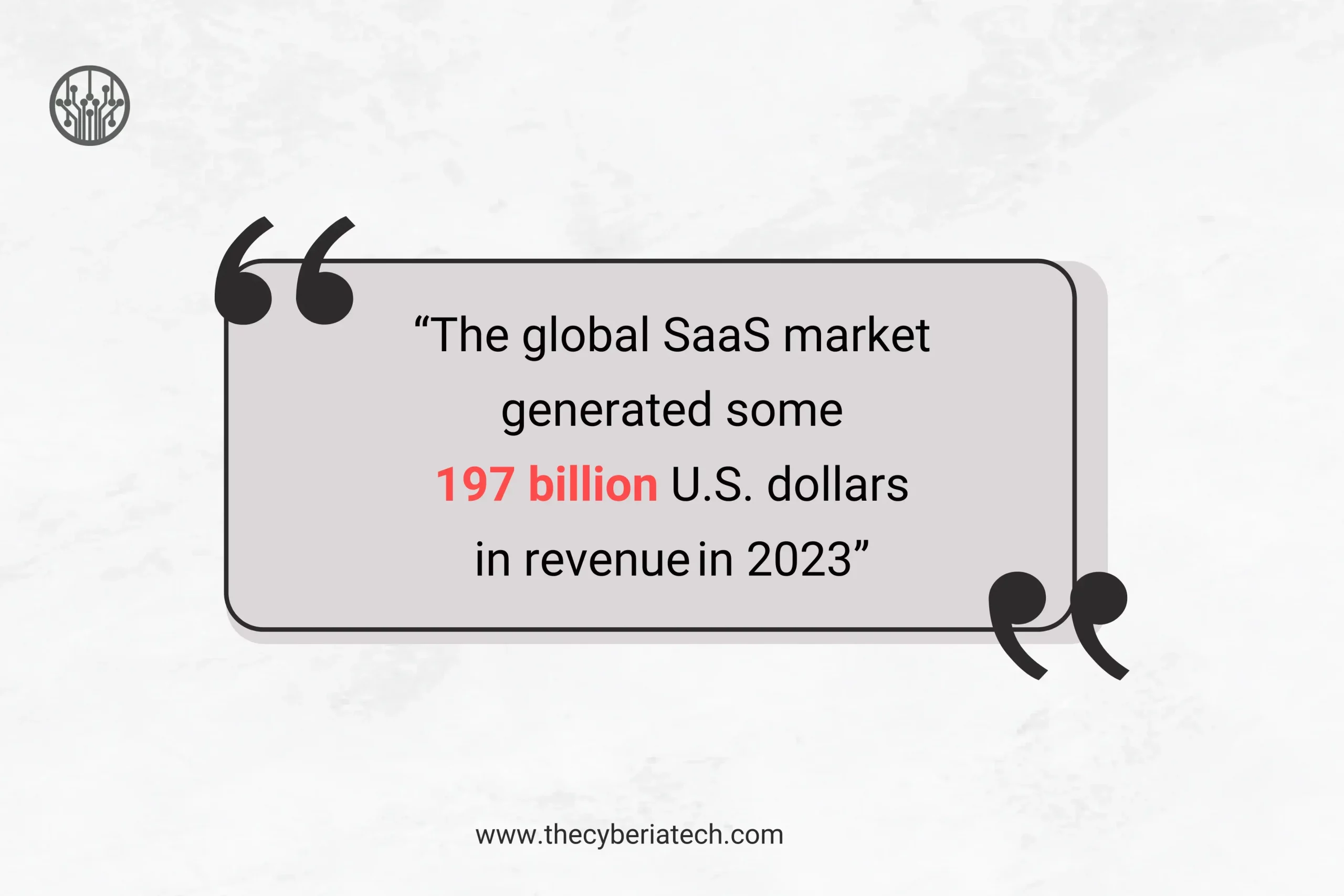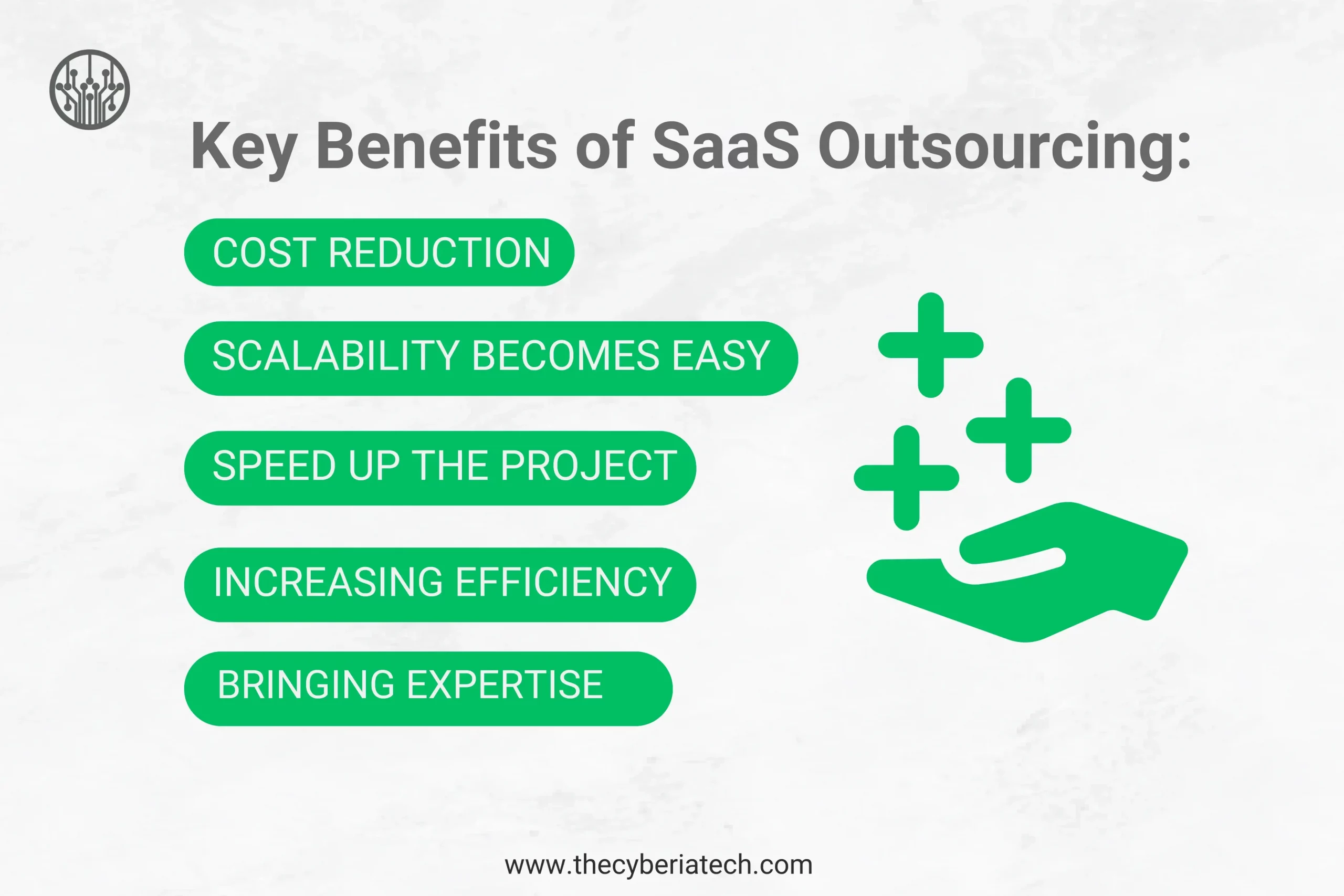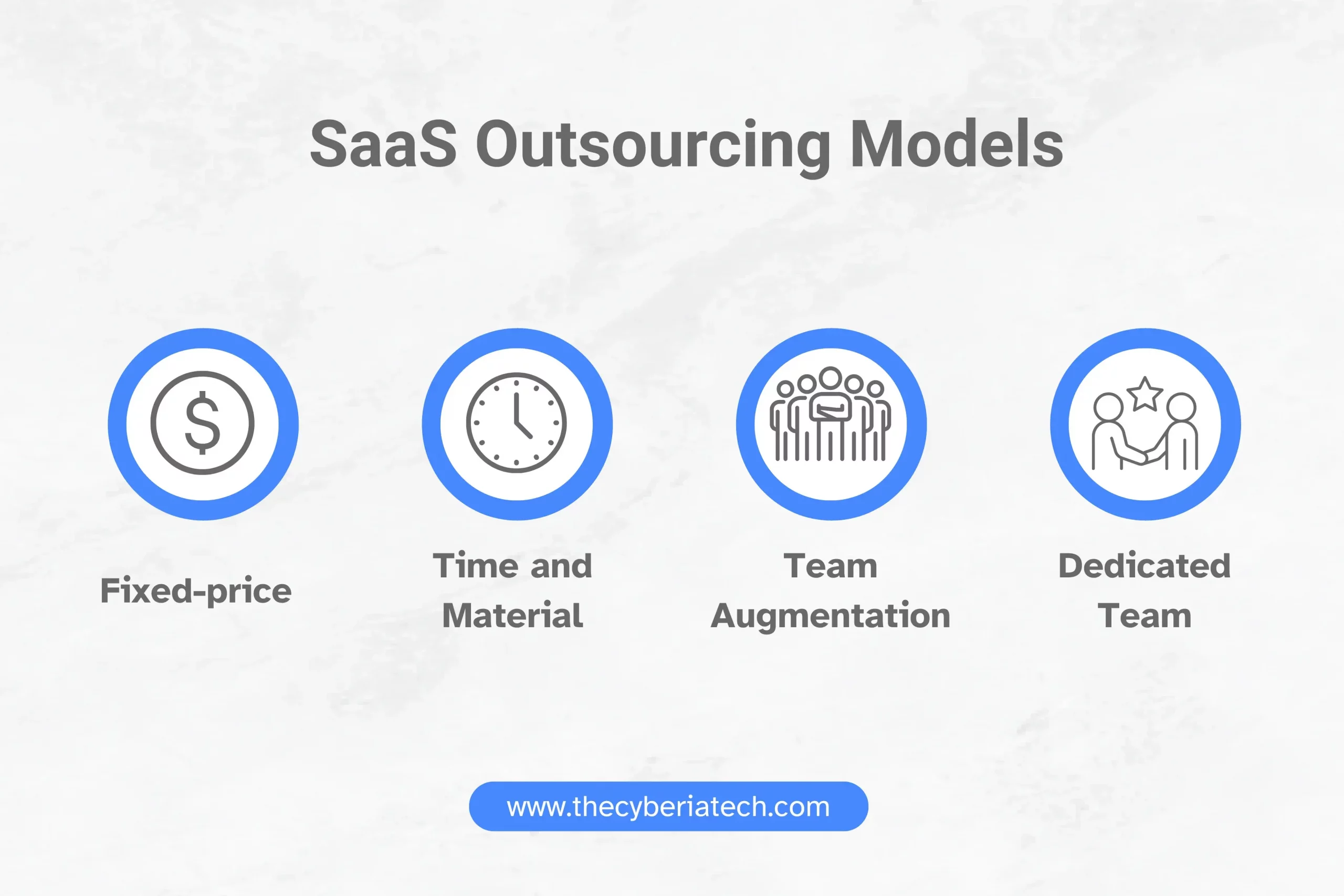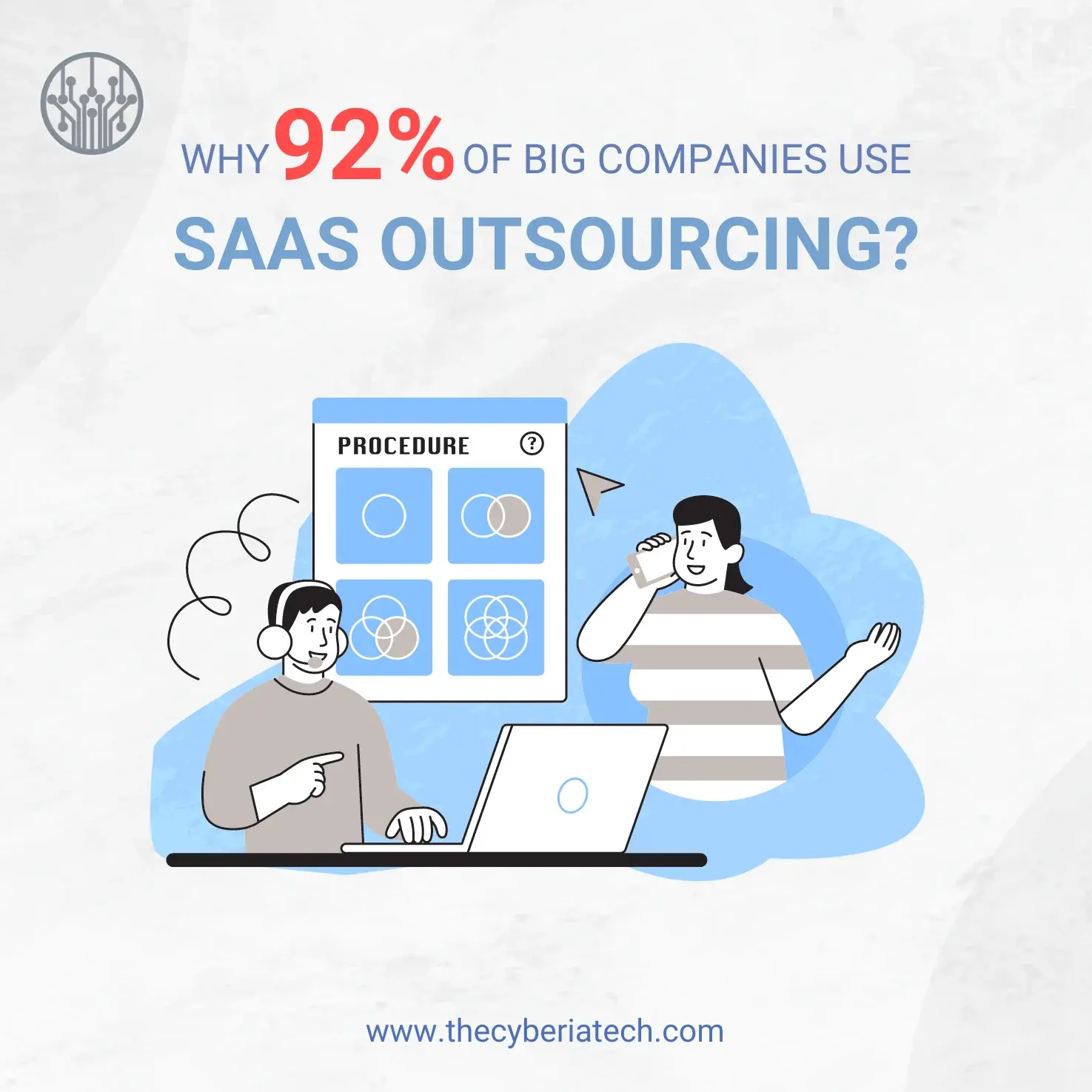According to ExplodingTopics.com, SaaS applications account for 70% of total company software use. As Software as a Service (SaaS) is a growing market, lots of companies are looking for SaaS outsourcing services.
In this article, we’re going to explain how your company can benefit from outsourcing SaaS projects. We’ll also explain how to get ready for outsourcing and how to find the right partner. Additionally, you’ll learn about the outsourcing model that best fits your business.
What is SaaS Outsourcing
SaaS outsourcing means hiring a service provider to handle tasks like software development, testing, and customer support for SaaS applications. These tasks include software development, management, support, and delivery of the product.
According to an article on Statista.com by Lionel Sujay Vailshery, “The global SaaS market generated some 197 billion U.S. dollars in revenue in 2023, accounting for approximately two-thirds of the entire public cloud services market revenue.”
It’s no surprise that companies are pushing themselves to have a portion of this cheesy pizza.

You may be wondering why a business should contract another company to build a SaaS. Below, you’ll find the answer to that.
Why Does SaaS Outsourcing Help Your Company Grow
Software as a service is a cloud-based software that allows users to run and use an application online without needing to install it on their computer. It means all the functions are done on the server side and don’t need resources from the client side.
Users can get access to a SaaS service through a browser, desktop, or mobile application. Google Docs is a well-known example of SaaS. It lets you write or edit documents in real time by just signing in to your Gmail, and you can access it from anywhere.
To build, maintain, and improve a SaaS project, companies need a notable amount of money, technical expertise, and other resources. Aside from that, the development process is time-consuming.
All of the requirements mentioned above are challenging for companies. For that reason, they opt for outsourcing SaaS development. This model presents a versatile solution that helps your businesses reduce costs, improve efficiency, introduce your product faster to the market, and focus on your core tasks.
If you want to know why it’s better to outsource SaaS projects, here are three reasons:
- SaaS products have numerous components, which makes them a process that requires a lot of time and energy.
- There are numerous tools, services, and APIs engaged in a SaaS project. All of these need constant support and monitoring which means more budget and human resources for you.
- SaaS products have to change at a fast pace to maintain their position in the market. Users want new features every day, and to meet their expectations, the product owner should migrate to new technologies and scale up the project.
Time and money are your most valuable assets. By delegating another company to build your SaaS product, you can save these precious assets and spend them in other areas of your business. That’s where outsourcing your project comes to your rescue.
Key Benefits of SaaS Outsourcing
We talked about the challenges that companies face in developing a SaaS product. In the image below, we’ve listed the advantages of SaaS outsourcing.

Now we go through the details of how you can benefit from assigning another company to develop your SaaS product:
Cost Reduction
SaaS business outsourcing is an effective way to reduce expenses. You may be asking how. Well, businesses don’t need to worry about costly software and licenses, as the outsourcing company will take care of the resources and infrastructure.
Outsourcing also saves you money on hiring, managing, educating, and retaining your staff. You can have talented developers working on your project at a highly competitive price. So, you’ll spend less money on payroll and other operational costs.
The service provider takes care of employment procedures and administrative procedures. This way, you’ll have more time to focus on the other aspects of your business (more on this in the next section).
For that reason, SaaS outsourcing is a good strategy to save money in different stages of software development.
Increasing Efficiency with SaaS Outsourcing
The recruitment process is another reason why many businesses choose this business model. Hiring an in-house team demands substantial investments of both time and capital. It may take several weeks (or even months) to put together your ideal SaaS development team.
But don’t just take our word for that.
According to the US Bureau of Labour Statistics, there is a shortage of engineers in the USA. In simple terms, there will be only one person per 7.4 job vacancy. This shortage results in about $8 trillion in income loss for businesses.
Hiring an external team enables you to allocate more resources towards critical areas like marketing, sales, customer management, and strategic planning for growth. Simply put, you concentrate on growing your business as your product prepares for its market debut.
In the next section, we will tell you how this extra time lets you start your project within weeks.
Speed up the Project
Setting up and instantly kicking off the project is another advantage of outsourcing SaaS development. SaaS projects need multiple people working on them. The team, which includes UI-UX designers, stack developers, and engineers, requires training to collaborate effectively.
Building, training, and expanding a full team requires an immense time and energy commitment as the project gets bigger. SaaS outsourcing companies have the resources and experience to bring together an agile team or add members based on the client´s needs.
How does this work in your favor?
Well, the outsourcing team has worked together on previous projects. So, you don’t have to spend time explaining each process and matching the squad together. This extra time gives you a competitive advantage because you can deliver your product to market faster.
Scalability Becomes Easy
In today’s world, it’s crucial to introduce features to users as quickly as possible. Otherwise, you won’t have the upper hand in this highly competitive market. Outsourcing makes it possible to have the right people at the right time when you need them.
Since you don’t waste your time going through a bulk of CVs and interviewing specialists, you can introduce your product to the market in time (or earlier than your competitors). It’s evident that “the early bird catches the worm.”
Bringing Expertise Inside
As previously stated, SaaS is a complex project that requires attention in cloud services, application development, integrations, and so on.
A professional team with a combination of skills helps you develop your project the way you have it in mind. They also help you choose the best technology for your product.
Moreover, focusing on strategic goals is important for the future growth of the SaaS product. A tech provider that has worked on SaaS projects for years can contribute to the product strategy and help you reach your goals.
How to Get Ready for SaaS Outsourcing
After reading the benefits of handing your SaaS project to a vendor, it´s time to get ready for the outsourcing process. Before starting SaaS development outsourcing, you may be asking:
- What do you need from the outsourcing company? First of all, it’s important to be aware of what you need from the service provider. If you don’t specify your needs, you may end up with a solution that doesn’t do any good for your business.
- When outsourcing, how can I control my business? If you clearly define your terms and conditions, you’ll reduce the risk of getting your venture out of hand.
- Is SaaS outsourcing cost-effective? We recommend conducting research to determine whether the outsourcing solution provides a cost-effective alternative.
- How do I manage communications with the outsourcing partner? Having a stable method to communicate with the service provider is necessary. Zoom and Google Meet help you with online meetings, while tools like TeamViewer enable parties to get direct access to the computers and make changes when needed.
If you have doubts about issues like cultural barriers, data security, intellectual property, and how to deal with problems, here are the most important outsourcing questions to ask before assigning a third party to start your project. You will also find the answers to these questions to ensure beneficial cooperation.
How to Choose a Partner for Outsourcing SaaS Development
You must collaborate with a reputable outsourcing firm that is skilled in executing your assignments. In this section, we’ll give you a few tips on how to choose your ideal SaaS outsourcing partner:
- Research potential vendors: In the first step, you should be aware of the process so you know what to expect from a partner. Afterwards, you should research them online or on other websites such as Clutch.co or GoodFirms to understand their background.
- Check the reviews: Read the testimonials on their website or in Google Reviews. If the reviews are real, you can contact the clients on LinkedIn and ask them if they are happy with the service.
- Check the portfolio: Check if they have experience and expertise in SaaS development. Go through case studies and success stories, and ask for client references.
- Evaluate communication: Interaction is the backbone of the development process. Make sure they can collaborate with you via the right channel without any problems.
- Pay attention to cultural differences: Cultural alignment is important for having a seamless partnership. A service provider who can fit your cultural norms will lower the risk of future conflicts.
- Have an intro call: It’s good to get to know each other in an online meeting or phone call. This is an effective way to learn more about the vendor and ask them questions about the procedure.
- Examine the SLA (Service Level Agreement): The SLA agreement defines the terms, the scope of work, timelines, costs, etc. You should check if the terms fit your business needs.
- Examine the contract. To avoid any further issues, it’s highly recommended to have a contract that completely defines the terms and conditions of the collaboration. If you’re interested in understanding the contents of an agreement with an outsourcing company, check out this blog post on IT outsourcing contracts with examples.
If you want to know what to ask the outsourcing vendor during the meeting or phone call, don’t miss the most important questions to ask an outsourcing partner.
SaaS Outsourcing Models
Whether you want to expand your in-house team or hire an external team, there is a model to match your goals. There are several models mentioned on the internet, but here we introduce 4 common types of outsourcing models in one frame.

In the following, we’ll uncover each one to help you select your ideal model:
Fixed-price
In this model, the vendor receives a settled fee to deliver a specific project at a certain time. For example, you’ll pay $3000 to the company for a website design. If you need to make changes or add another feature, you should expect a new agreement plus an extra fee.
This model is ideal when everything about your project is clear and agreed upon in advance. It’s a common model for large companies with big budgets. Smaller companies can choose the time-and-material model, as explained below.
Time and Material
Companies choose this model when it’s not possible to exactly estimate the time and cost of the project. It’s based on the tasks required by the client and the hours taken by the vendor to execute them.
The service provider charges the client an hourly rate, as well as expenses related to the facilities and tools used in the project.
Team Augmentation
Team augmentation (or staff augmentation) is a model that helps you complement your in-house team with a group of skilled specialists. They integrate into your existing team and assist in product development. This model will incur hourly rates.
Dedicated Team
In this model, you can recruit a team (or an individual) to fulfil your required tasks. This team works exclusively on your project. It’s like having a secondary team dedicated only to your project while the staff administration remains on the vendor’s side.
frequently asked questions
According to the EBA Guidelines’ broad definition of outsourcing, a SaaS arrangement where a regulated financial institution obtains software applications from a third-party service provider over the Internet would likely be considered an outsourcing arrangement under the EBA framework.
Software as a service is considered outsourcing because it enables companies to use software through the Internet, which is maintained and updated by external providers.
Wrapping Up
In this blog post, you learned why SaaS outsourcing is a smart move for companies. We discussed the benefits of outsourcing, including how it can help you reduce costs and increase efficiency.
Working with a trustworthy partner will help you build your software faster and gain a competitive edge. In this article, you discovered how to find a reliable service provider to develop your SaaS product.
We also went through various models of outsourcing. But before selecting a model, it is advisable to clearly define your objectives and discuss them with your partner to prevent any future conflicts.







